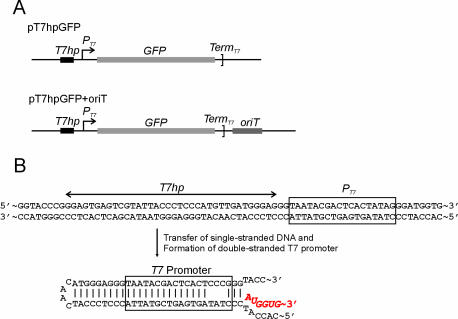Figure 4.
Plasmids for assaying conjugative DNA transfer between E.coli and T7RNAP-mitochondria. (A) Structures of control and mobilizing plasmids, pT7hpGFP and pT7hpGFP+oriT, respectively. The T7hp sequence was cloned in front of the T7 promoter (PT7) and was designed to form a double-stranded hairpin-loop T7 promoter after transferring the single-stranded plasmid DNA into the mitochondria by conjugation. Only the mobilizing plasmid contains the oriT sequence. (B) A schematic representation for the formation of a double-stranded hairpin-loop T7 promoter. Once a DNA strand is transferred to T7RNAP-mitochondria by conjugation, spontaneous annealing around the T7 promoter region in the ssDNA will form a fully duplexed T7 promoter inside the mitochondria. T7RNAP can recognize this duplexed sequence (27,28) and initiate transcription of an RNA molecule (red characters).

